|
There was a time when most quality revolvers
were made of polished blued steel and walnut. These old guns
today are timeless masterpieces that stir the soul. Many modern
guns are matte coal black and lifeless plastic. They work and
work well for their intended purpose, and I own several myself.
However, to me they are simply tools, built to get the job done
with no frills or fanfare. Just tools. But the old classic Smith
& Wessons, Colts, Remingtons, and Rugers that
were built by craftsmen who could spend a few hours at a
polishing wheel before hand fitting the parts are the handguns
that stir my soul. In recent years, most manufacturers have
drifted away from blued steel and walnut, especially for double
action revolvers. There was a good reason for this. Most
shooters wanted stainless steel and rubber grips. Stainless is
more practical, and rubber makes for a good hold on the weapon
when firing. When S&W introduced the stainless Model 60 in
1965, for many years the little stainless Chiefs Special brought
premium prices, selling for much more than suggested retail,
because shooters just had to have that little stainless gun.
Other stainless models followed, and eventually, the polished
blued guns were fading away, falling from production in favor of
the stainless guns. Smith & Wesson continued to make limited
runs of blued guns, but for the most part, stainless was king.
Many shooters blame the manufacturers for not making the old
style polished blued guns anymore, but it is not the
manufacturers fault. They will build what we will buy. We were
buying stainless, and the blued guns went away.
Now some shooters are demanding the look,
quality, and feel of the older guns, and are willing to pay a
premium to get them. Manufacturers (some of them) are listening,
and we are able to buy new revolvers that are stronger and
better than the older guns, but with the same classic look of
polished blued or nickel-plated steel, and grips made of genuine
walnut, the same stuff that is still used to make trees.
I was glad to see that Smith & Wesson
introduced their Classic series of revolvers that are
reminiscent of the sixguns that were built decades ago, but made
with better steels on modern CNC machinery. I was especially
glad to see the Model 29 and Model 25 Classics, built on the big
N-frame with six and one-half inch barrels. They look just like
the gun packed by Harry Callahan in the old Dirty
Harry movies, which created such a demand for the Model
29 that they brought black-market prices for many years. The
first Model 29 that I ever handled was when I was a fifteen year
old kid, working at a McDonald’s in Clarksville,
Tennessee. I was the tater guy, peeling, cutting and cooking
about 2200 pounds of Idaho’s best every weekend. Fresh taters
cooked in beef fat. They sure tasted better back then. Anyway,
the restaurant manager was Hargis Chadwick, a rough
character at the time, but he did allow me to handle a few of
his guns, when he wasn’t cussing me out for something or
another. Hargis would, everyday, take the day’s cash deposit
and walk across the four-lane highway to the bank, bag of cash
in one hand, and a Model 29 .44 Magnum in the other. I wanted a
Model 29 badly, but at $1.15 per hour, it was unobtainable. Now,
the Model 29, along with Models 21, 22, 24, 27, and my favorite,
the Model 25, have returned as blued or nickeled N-frames in the
S&W Classic line, along with some models on the smaller
frames as well.
The new Model 25 Classic, Model 25-15 to be
precise, is chambered for the .45 Colt cartridge and wears a six
and one-half inch tapered barrel that measures a slim .604 inch
at the muzzle, and it balances beautifully in the hand. The
sights are black and easy to see well against a target for
precise shooting. The rear sight is the standard S&W fully
adjustable unit, and the revolver is drilled under the rear
sight for a scope mount. The sixgun weighs in at forty-two
ounces. Nothing feels quite like an N-frame in the hand, and
with the Model 25’s thin, long walnut grip, the revolver
points beautifully. The grip panels extend well below the bottom
of the grip frame. They are nicely checkered and perfectly
fitted. The grip is thinner in profile than the old target style
S&W grip, and feels much better in my hand. The hammer is
the wide, checkered target style, and the trigger is wide with
shallow vertical grooves. Both have a case-hardened finish. The
trigger pull in single-action mode measured a crisp three
pounds, thirteen ounces, but felt even lighter due to the wide
trigger. Double-action pull weight measures eight and
three-quarters pounds, and is very smooth, as an N-frame Smith
is expected to be. The firing pin is installed into the frame,
and is a stronger design than the older style with the pin in
the hammer. The sixgun has the S&W internal lock, should the
owner wish to use the device. Reliability was perfect, with no
failures to fire nor sticky ejection. Accuracy was excellent. I
clamped the Model 25 into my Ransom
Master Rest, and fired at a distance of twenty-five
yards to test for accuracy, firing a series of five-shot groups.
At first, accuracy was in the three inch range, strung
vertically, until I finally realized that I had not tightened
the elevation screw on the Ransom Rest. After correcting my
mistake, every group fired clustered between one and one-half to
one and three-quarters inches, with the best group just under
one and one-half inches. Also, the groups were getting slightly
tighter all the time. This is match grade accuracy from this .45
Colt handgun. The bullets used for accuracy testing were the
270SAA from Mt. Baldy Bullets
in Cody, Wyoming. They are a modified Keith design, and
weigh about 280 grains. I loaded them atop 6.6 grains of Trail
Boss powder with a Winchester WLP primer. I was impressed by the
accuracy of the Model 25. Cylinder throats measured a consistent
.4515 inch, and the barrel/cylinder gap measured six
one-thousandths (.006) inch.
The new Classic Model 25 is not cheap, but is
still a good value, and in today’s dollars, the Model 25 is
more affordable now than it was fifty years ago.
Check out the Classics and all Smith &
Wesson products online at www.smith-wesson.com.
For the Location of a Smith & Wesson dealer
near you, click on the DEALER FINDER at www.lipseys.com.
To order the Model 25 online, go to www.galleryofguns.com.
To order some of the superb 270SAA bullets
online, go to www.mtbaldybullets.com.
Jeff Quinn
NOTE: All load data posted on this
web site are for educational purposes only. Neither the author nor
GunBlast.com assume any responsibility for the use or misuse of this data.
The data indicated were arrived at using specialized equipment under
conditions not necessarily comparable to those encountered by the
potential user of this data. Always use data from respected loading
manuals and begin working up loads at least 10% below the loads indicated
in the source manual.
| For a list of dealers where you can
buy this gun, go to: |
|
To buy this gun online, go to: |
 |
|

|
|
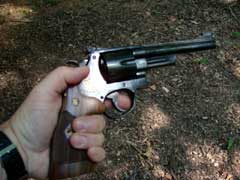
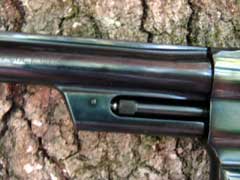
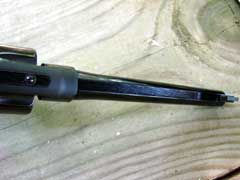
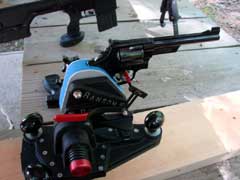
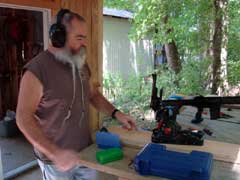
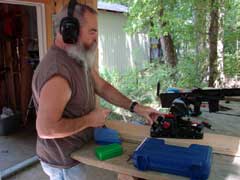
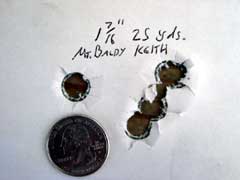
Accuracy testing the Classic Model 25.

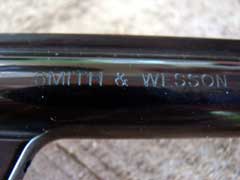
|
  
Got something to say about this article? Want to agree (or
disagree) with it? Click the following link to go to the GUNBlast Feedback Page.
|
|
Click pictures for a larger version.
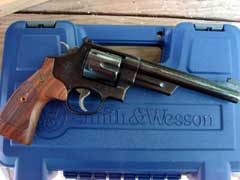
Smith & Wesson's Classic Model 25.
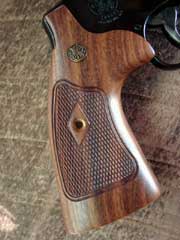
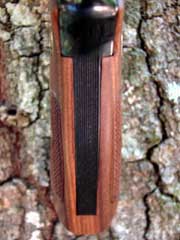
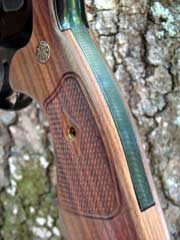
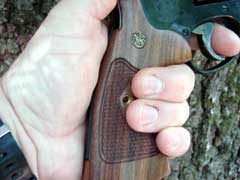
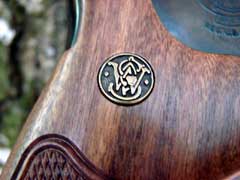
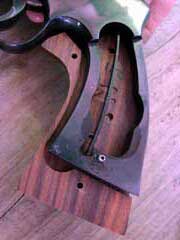
Grips are well-designed and beautifully executed.

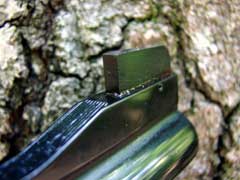
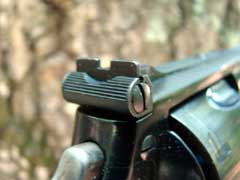
Sights are S&W's excellent fully-adjustable rear
with pinned-blade front, and are plain black for precise
target shooting.
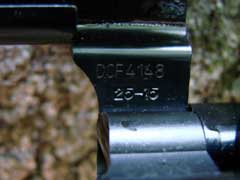
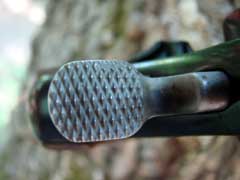


Hammer (top & center) is a wide-spur checkered
design, and trigger (bottom) is a wide grooved target style.
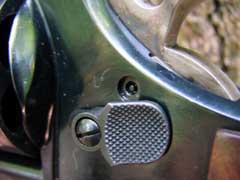
Smith & Wesson's internal key lock.
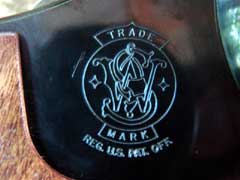
|
![]()